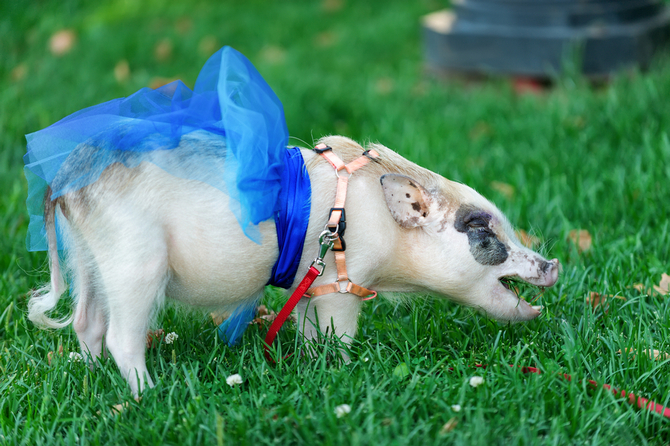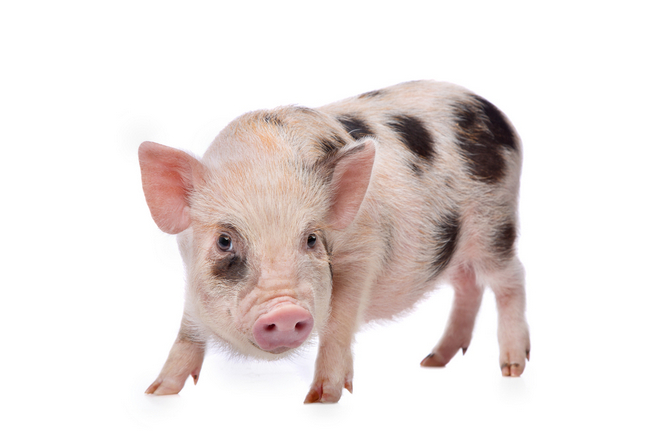How to Correctly Feed a Teacup Pig
Teacup pigs have become increasingly popular choices as pets. This is unsurprising as pigs are smart, cute, and fun animals to have around. Since Teacup pigs are much smaller than the average potbellied or butcher pig, they are just the right size to keep in a house or large apartment. When a person decides to take home a teacup pig, it is important that, like any other pet, they know how to properly take care of their new pet. Teacup pigs do not eat the same food as cats, dogs, or humans, so it is important to properly research what to feed a teacup pig. Here are some guidelines on feeding a teacup pig.

Basic Foods
Mini pigs should be regularly fed a well balanced diet. Most people opt to feed their pigs a packaged brand of food pellets. It is important to note that owners need to purchase food specifically for teacup pigs rather than livestock pigs. One such food, for young teacup pigs, is available from Mazuri and can be found here. The same brand also offers food for adult and elder pigs. Teacup pig owners can choose to make their own food, as well. This site offers some suggestions. When one chooses to make their own teacup pig food, it is necessary to remember that grains like hay and wheat are also crucial parts of a pig's diet.
In addition to this food, pigs should also be fed fresh vegetables and roughage. Approximately a quarter of their diet should come from these sources.
Good Vegetables and Roughage for Mini Pigs
- Leafy Greens
- Cucumbers
- Celery
- Potatoes
- Bell Peppers
- Grass (teacup pigs can graze from lawns for an easy source of roughage)
Treats
Just like other pets, pigs love getting treats. Treats are especially useful tools when training pigs.
Good Treat Options for Pigs
- Packaged Pig Treats - These can be purchased from the same place as pellet food.
- Fruits - Pigs love fruits. However, pig owners should be careful not to feed them too much. Pigs should receive a maximum of two servings per day of fruit.
- Grains - Grains that do not contain butter or salt. Some good options are unsalted popcorn, crackers, and cereal without sugar (like Cheerios).
- Extra Vegetables

Foods Not to Feed Teacup Pigs
Certain foods can be dangerous or toxic to pigs. Pig owners should always check before feeding their pigs new foods.
Known Bad Foods
- Meat or Bones
- Dog Food
- Sweet Foods, Especially Chocolate or Ice Cream
- Cereal with Added Sugar
- Food Items Containing Caffeine
- All Parts of Avocados
- Onions
- Tea
- Salty Foods
- Oak Leaves and Acorns
- Raw Elderberries, Kidney Beans, and Lima Beans
- Moldy Walnut Shells
- Castor Beans
- Rhubarb Leaves
- Green Parts of Potatoes, Potato Leaves, and Decayed Sweet Potatoes
- Corn Stalks
- Tomato Vines and Leaves
- The Leaves and Seeds of Apples, Apricots, Peaches, Plums, Cherries, Nectarines, and Pears
- The Roots and Seeds of Mustard, Turnips, Broccoli, and Cabbage
- Tobacco Leaves
- Large Amounts of Nutmeg
- Cassava Roots and Leaves
- Large Quantities of Flaxseed
- Almond Leaves and Seeds
- Raw Cashews
Water
Teacup Pigs need constant access to water. Owners should replace water regularly or when the water becomes dirty. Pigs like to flip over their water bowls, so it is a good idea to use a heavy bowl that they will not be able to move. Pigs should also be given water to clean off and play in. Pigs do not sweat like humans do, so they need a body of water to cool off in. A baby swimming pool is an easy way to provide this.
How Much Should Teacup Pigs Eat
It is important that owners feed their pigs the correct amount. Feeding them too much can lead to obesity. Too little food can cause malnourished pigs and even death.
Different pigs may need to eat different amounts. Baby piglets should usually eat a quarter of a cup of pellets in the morning and then another quarter in the evening. It is a good idea to add water to the pellets, giving the baby an equal amount of food and water. A general rule as the mini pigs grow is to feed them two percent of their weight a day. It's a good idea to divide this into a morning and evening feeding.
This guideline does not apply to every pig. If a teacup pig has a slower metabolism or is less active then they will need less food. For the reverse, they will need more. It is important to carefully monitor a teacup pig's size and actions. Owners should not be able to see their pig's rib or hip bones. Mini pigs, especially young piglets, should have healthy skin and clear eyes. They should be alert, active, and have a keen interest in their surroundings. Signs of malnutrition, starvation, and serious illness are bad skin, dull eyes, lack of interest, and lethargy.
This website has a chart and graphic to help owners feed their pigs.
Other Things to Know
Pigs do not have a thalamus, which would let them know that they are full. Pigs will not stop eating even if they are full. They may even try to break into a refrigerator or cabinet. Owners should be careful to secure these areas as pigs are intelligent and may be able to break in.
If adjusting a pig's food intake does not help to improve their mood or weight, it is important that the owner contact a veterinarian with knowledge of teacup pigs. Here is a list of vets that can see teacup pigs.